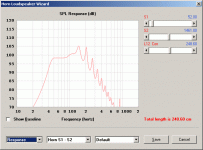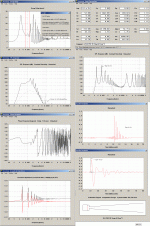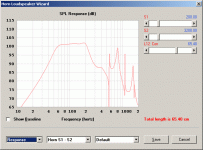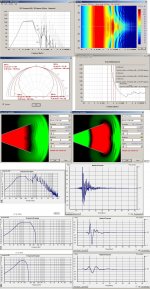...or how to get 98dB @1W/1M @ 50 Hz (and 93dB @ 40 Hz) from a cheap 8" driver ...
This is my first foray into FLH design. The sims suggest a ridiculous amount of output from a simple 8" driver that costs a bit over $40, the main disadvantage being the 5.7 cu.ft. (net) box requirement, but there might be something else I'm not seeing - please check, thanks.
HornResp data...
ID=23.40
Ang=2.0 x Pi
Eg=2.00
Rg=0.00
Fta=4.03
S1=52.00
S2=1461.00
Con=248.60
F12=0.00
S2=0.00
S3=0.00
L23=0.00
F23=0.00
S3=0.00
S4=0.00
L34=0.00
F34=0.00
S4=0.00
S5=0.00
L45=0.00
F45=0.00
Sd=213.80
Bl=10.12
Cms=5.19E-04
Rms=1.73
Mmd=51.71
Le=1.76
Re=3.53
Nd=1
Vrc=9.90
Lrc=19.70
Fr=0.00
Tal=0.00
Vtc=4000.00
Atc=462.80
Com=FLH POC #1
This is my first foray into FLH design. The sims suggest a ridiculous amount of output from a simple 8" driver that costs a bit over $40, the main disadvantage being the 5.7 cu.ft. (net) box requirement, but there might be something else I'm not seeing - please check, thanks.
HornResp data...
ID=23.40
Ang=2.0 x Pi
Eg=2.00
Rg=0.00
Fta=4.03
S1=52.00
S2=1461.00
Con=248.60
F12=0.00
S2=0.00
S3=0.00
L23=0.00
F23=0.00
S3=0.00
S4=0.00
L34=0.00
F34=0.00
S4=0.00
S5=0.00
L45=0.00
F45=0.00
Sd=213.80
Bl=10.12
Cms=5.19E-04
Rms=1.73
Mmd=51.71
Le=1.76
Re=3.53
Nd=1
Vrc=9.90
Lrc=19.70
Fr=0.00
Tal=0.00
Vtc=4000.00
Atc=462.80
Com=FLH POC #1
Attachments
hmm, it's possible that the amount of compression is a bit much for the cone... but maybe it's strong enough. depends if you'll be running it all full tilt all the time or not.
but that's another advantage of small speakers, they can hold up better with larger compression ratio's.
the output is normal for a horn.
but that's another advantage of small speakers, they can hold up better with larger compression ratio's.
the output is normal for a horn.
Last edited:
hmm, it's possible that the amount of compression is a bit much for the cone... but maybe it's strong enough.
the output is normal for a horn.
Thanks. While the throat is a bit small, there's actually a fairly large chamber in front of the driver's cone. In the schematic, it looks like a 4th order BP box loaded with a horn instead of a vent.
Thanks. While the throat is a bit small, there's actually a fairly large chamber in front of the driver's cone. In the schematic, it looks like a 4th order BP box loaded with a horn instead of a vent.
Hi Brian,all
Agree, Compression of the front (or rear) chamber volume is IMO ok if not exceeding 5 %, i.e. 5 % of 4 L is 0.2L; 0.2L/ Sd = ~9.4 mm. 9.4 mm corresponds to a midband SPL of about 121 dB if this excursion is allowed for the driver.
My 2 cents thou: Delaying the main speakers can be an issue if used in home environments, IMO at least 5 mS is necessary.
b
Attachments
Hi Brian,all
Agree, Compression of the front (or rear) chamber volume is IMO ok if not exceeding 5 %, i.e. 5 % of 4 L is 0.2L; 0.2L/ Sd = ~9.4 mm. 9.4 mm corresponds to a midband SPL of about 121 dB if this excursion is allowed for the driver.
My 2 cents thou: Delaying the main speakers can be an issue if used in home environments, IMO at least 5 mS is necessary.
b
Thaks Bjorno. The driver's Xmax is about 9mm. I can probably up the front chamber volume a bit with too much impact on the response.
The simulation shows 2PI response for direct comparison with vented alignments, but it's likely going to be used 1PI or even 0.5PI if this thing ever gets built.
Hi Brian,all
Agree, Compression of the front (or rear) chamber volume is IMO ok if not exceeding 5 %, i.e. 5 % of 4 L is 0.2L; 0.2L/ Sd = ~9.4 mm. 9.4 mm corresponds to a midband SPL of about 121 dB if this excursion is allowed for the driver.
My 2 cents thou: Delaying the main speakers can be an issue if used in home environments, IMO at least 5 mS is necessary.
b
Bjorno, if you had a choice, would you build this horn, or the one I've illustrated below? Actually this new horn isn't not a true "horn", but a bandpass system with a short horn instead of a vent (like the DecWare Wicked One) - apparently this extends the upper frequency response, according to the HornResp results.
HornResp Stuff:
ID=23.40
Ang=2.0 x Pi
Eg=2.80
Rg=0.00
Fta=20.10
S1=200.00
S2=3200.00
Con=65.40
F12=0.00
S2=0.00
S3=0.00
L23=0.00
F23=0.00
S3=0.00
S4=0.00
L34=0.00
F34=0.00
S4=0.00
S5=0.00
L45=0.00
F45=0.00
Sd=881.00
Bl=18.53
Cms=1.43E-04
Rms=3.89
Mmd=85.39
Le=0.92
Re=5.31
Nd=1
Vrc=55.00
Lrc=31.30
Ap=31.10
Lpt=0.00
Vtc=44000.00
Atc=2000.00
Com=Eminence Kappalite 3015LF FLH 2
Xmax=9.6mm
The intent here is to build something that can keep up with some full range units that supposedly can do 130dB each down to 150 Hz or so. Must reach down to at least 50 Hz, and the subs are likely to be corner loaded. The 15" driver for the second design costs almost four times that of the 8" driver from the first design, but it can handle a bit more power.
Attachments
Bjorno, if you had a choice, would you build this horn, or the one I've illustrated below? Actually this new horn isn't not a true "horn", but a bandpass system with a short horn instead of a vent (like the DecWare Wicked One) - apparently this extends the upper frequency response, according to the HornResp results.
..The intent here is to build something that can keep up with some full range units that supposedly can do 130dB each down to 150 Hz or so...
Hi Brian,
Your simulation looks good to me and I would definitively copy your design if I needed a shrinking beam width starting above about 200Hz in order to align the polar response to another driver.
The Eminence 3015 LF driver is IMO a very good choice for this purpose.
b
bjorno wouldnt the irregular mouth shape,that typically expands in only one dimension cause polar irregularities, and at the same time be swamped by in room resonances? ..
Hi neddludd,
Yes it does and when looking at the FR above 300Hz there is a shelf less than 10 dB down popping up* that for transients could draw localization attention (phantom image spread hang down) to the speakers as this FR region is probably close to the room upcoming Schroeder frequency where a rather smooth FR is expected.
So if using the Bass speakers in an acoustically overlap system at a XO over 200 Hz I believe there is still a need for some Eq: ing of the response.
OTOH if the speakers are XO: ed lower, there shouldn’t be any problems as you wrote: The eventual irregularities would be swamped by the room modals.
*The criteria is that for no localization effects to be heard, the level for an bass speaker should be about 20 dB down at about 250 Hz when the mouth is placed near floor.
b
Hi neddludd,
Yes it does and when looking at the FR above 300Hz there is a shelf less than 10 dB down popping up* that for transients could draw localization attention (phantom image spread hang down) to the speakers as this FR region is probably close to the room upcoming Schroeder frequency where a rather smooth FR is expected.
So if using the Bass speakers in an acoustically overlap system at a XO over 200 Hz I believe there is still a need for some Eq: ing of the response.
OTOH if the speakers are XO: ed lower, there shouldn’t be any problems as you wrote: The eventual irregularities would be swamped by the room modals.
*The criteria is that for no localization effects to be heard, the level for an bass speaker should be about 20 dB down at about 250 Hz when the mouth is placed near floor.
b
b
Attachments
- Status
- This old topic is closed. If you want to reopen this topic, contact a moderator using the "Report Post" button.
- Home
- Loudspeakers
- Subwoofers
- Let's talk about FLHs...



